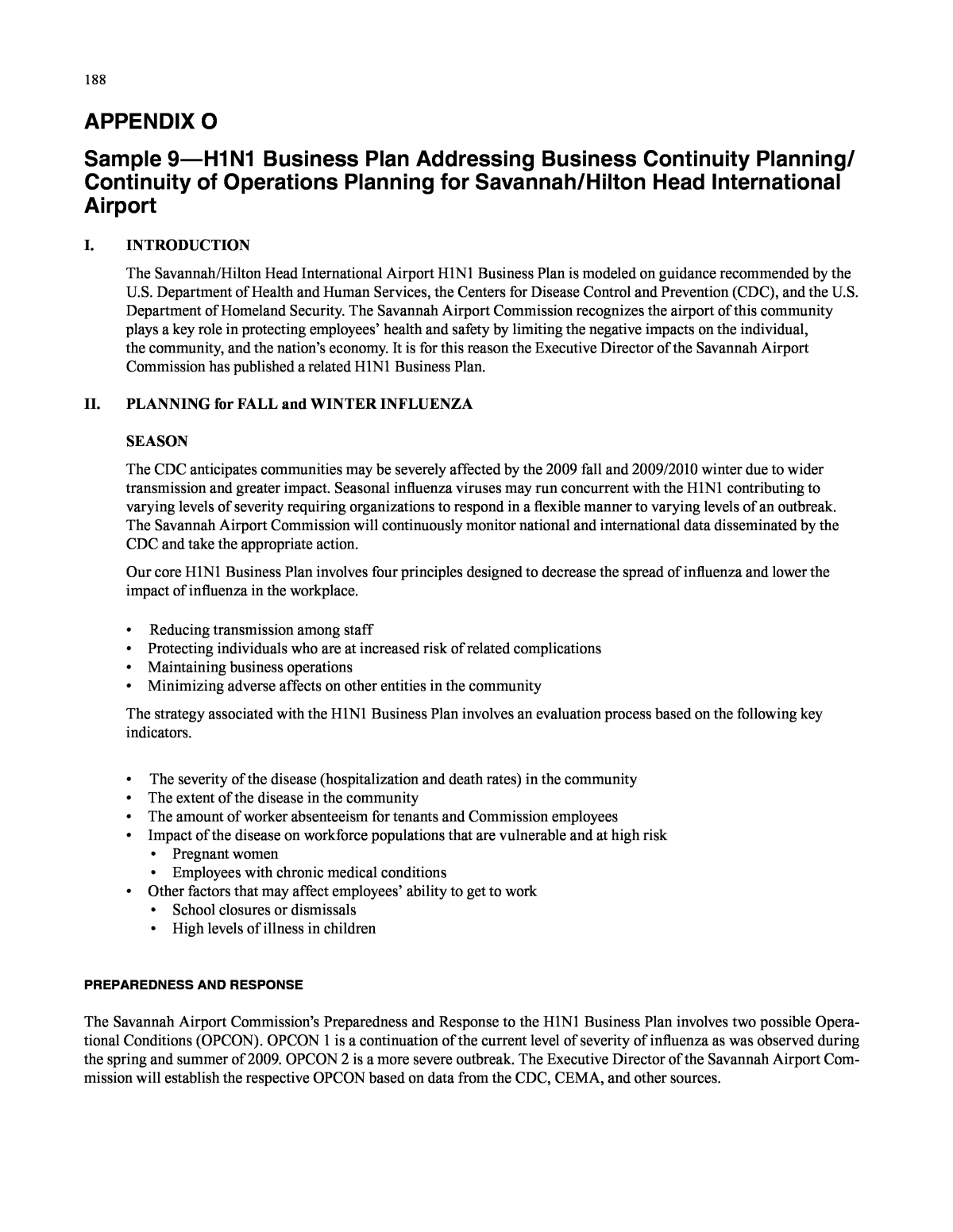

Below is the uncorrected machine-read text of this chapter, intended to provide our own search engines and external engines with highly rich, chapter-representative searchable text of each book. Because it is UNCORRECTED material, please consider the following text as a useful but insufficient proxy for the authoritative book pages.
188 I. INTRODUCTION The Savannah/Hilton Head International Airport H1N1 Business Plan is modeled on guidance recommended by the U.S. Department of Health and Human Services, the Centers for Disease Control and Prevention (CDC), and the U.S. Department of Homeland Security. The Savannah Airport Commission recognizes the airport of this community plays a key role in protecting employeesâ health and safety by limiting the negative impacts on the individual, the community, and the nationâs economy. It is for this reason the Executive Director of the Savannah Airport Commission has published a related H1N1 Business Plan. II. PLANNING for FALL and WINTER INFLUENZA SEASON The CDC anticipates communities may be severely affected by the 2009 fall and 2009/2010 winter due to wider transmission and greater impact. Seasonal influenza viruses may run concurrent with the H1N1 contributing to varying levels of severity requiring organizations to respond in a flexible manner to varying levels of an outbreak. The Savannah Airport Commission will continuously monitor national and international data disseminated by the CDC and take the appropriate action. Our core H1N1 Business Plan involves four principles designed to decrease the spread of influenza and lower the impact of influenza in the workplace. ⢠Reducing transmission among staff ⢠Protecting individuals who are at increased risk of related complications ⢠Maintaining business operations ⢠Minimizing adverse affects on other entities in the community The strategy associated with the H1N1 Business Plan involves an evaluation process based on the following key indicators. ⢠The severity of the disease (hospitalization and death rates) in the community ⢠The extent of the disease in the community ⢠The amount of worker absenteeism for tenants and Commission employees ⢠Impact of the disease on workforce populations that are vulnerable and at high risk ⢠Pregnant women ⢠Employees with chronic medical conditions ⢠Other factors that may affect employeesâ ability to get to work ⢠School closures or dismissals ⢠High levels of illness in children PREPAREDNESS AND RESPONSE The Savannah Airport Commissionâs Preparedness and Response to the H1N1 Business Plan involves two possible Opera- tional Conditions (OPCON). OPCON 1 is a continuation of the current level of severity of influenza as was observed during the spring and summer of 2009. OPCON 2 is a more severe outbreak. The Executive Director of the Savannah Airport Com- mission will establish the respective OPCON based on data from the CDC, CEMA, and other sources. APPENDIX O Sample 9âH1N1 Business Plan Addressing Business Continuity Planning/ Continuity of Operations Planning for Savannah/Hilton Head International Airport
189 OPCON 1 ⢠The Director of Operations or his or her designee will conduct an OPCON 1 H1N1 briefing to all Savannah Airport Commission employees. ⢠The Marketing Department will advise airline tenants, concession tenants, and lessees that the Executive Director has implemented OPCON 1. ⢠Establish normal influenza absenteeism rates and begin to track variances above the norm. ⢠Employees are encouraged to get vaccinated against influenza. ⢠Employees at higher risk for complications from influenza, to include pregnant women, employees with chronic lung disease, diabetes, and diseases that suppress the immune system, should check with their health care provider if they become ill. ⢠Assess essential business functions and determine at what threshold of absenteeism airport functions may be affected. ⢠All individuals exhibiting influenza symptoms should stay home and away from the workplace and will not return until 24 hours after the fever is resolved. ⢠Ensure health practices such as hand washing and covering coughs and sneezes are in place. ⢠Employees who are well but have an ill family member at home with influenza should monitor their health daily and not report to work if they exhibit symptoms of influenza. ⢠Routine cleaning of commonly touched surfaces will be performed by Environmental staff. OPCON 2 ⢠The Director of Operations or his designee will conduct an OPCON 2 H1N1 briefing to all Savannah Airport Commission employees. ⢠The Marketing Department will advise airline tenants, concession tenants, and lessees that the Executive Director has implemented OPCON 2 . ⢠Review influenza absenteeism rates and meet with the Executive Director to determine a projection of the absen- teeism rate. ⢠Each Department Manager will provide the Director of Operations or his designee with adverse functionality conditions of their Department based on current absenteeism trends. ⢠The Executive Director and Director of Operations in coordination with the CDC and CEMA will review data and determine the functional level of the airport based on absenteeism rates. ⢠The Executive Director will implement policy associated with work eligibility based on symptoms and CDC or Health Department recommendations as well as return to work policy. ⢠The Executive Director or his designee may require social distancing (non-contact with other employees within a given distance) to include reassignment of work space. ⢠Conference rooms will be closed with the exception of Executive use. ⢠The Executive Director or his designee may implement work-from-home strategies to maintain functionality of the airport. ⢠Employees who exhibit flu-like symptoms are encouraged not to travel and are not permitted to travel on behalf of the Savannah Airport Commission.
